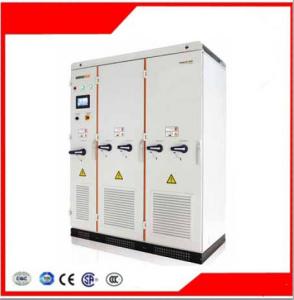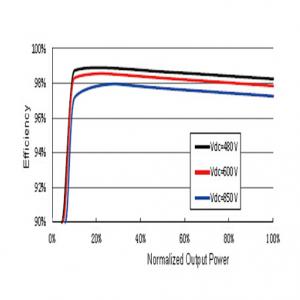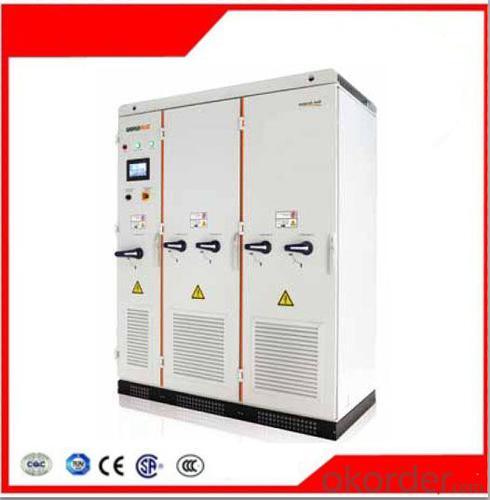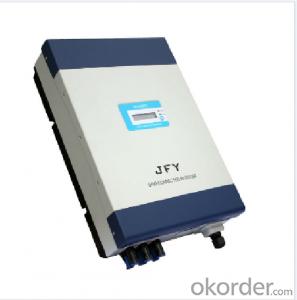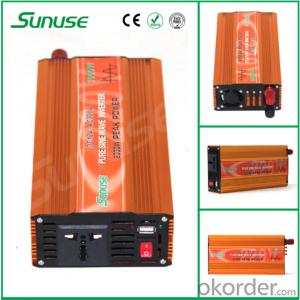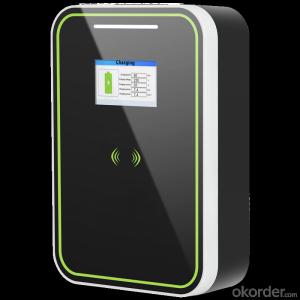Photovoltaic Grid-Connected Inverter SG500MX-M
- Loading Port:
- China Main Port
- Payment Terms:
- TT or LC
- Min Order Qty:
- 50 unit
- Supply Capability:
- 1000 unit/month
OKorder Service Pledge
OKorder Financial Service
You Might Also Like
1. Structure of Photovoltaic Grid-Connected Inverter SG500MX-M Description
A solar inverter, or PV inverter, or Solar converter, converts the variable direct current (DC) output of a photovoltaic (PV) solar panel into
autility frequency alternating current (AC) that can be fed into a commercial electrical grid or used by a local, off-grid electrical network.
It is acritical BOS–component in a photovoltaic system, allowing the use of ordinary AC-powered equipment. Solar inverters have
special functions adapted for use with photovoltaic arrays, including maximum power point tracking and anti-islanding protection.
Suitable for 50Hz/60Hz grid, could be used in Asia, North America and Europe.
2. Main Features of the Photovoltaic Grid-Connected Inverter SG500MX-M
• Advanced three-level circuit structure improves product's performance
• 4-MPPT, wide MPP voltage range
• Modular design, long operation time
• Film bus capacitors with long lifespan
• Rotating the modules in use extends the inverter's lifespan
• Inverter sleeping at night doubles the PCB lifespan
• Elevated cooling performance and protection level ensures reliable operation
• Less THD, more grid-friendly
• Less common-mode interference, more environment-friendly
• Compatible with two-winding transformer
• Flexible setting of 1 to 4 MPPT
• Reactive compensation on asymmetric power grid
• Direct parallel connection at low voltage side, easy to expand the capacity
• Comprehensive modular design
• All components front-maintenance
• Draw-type modules, service friendly design
• Less THD, more grid-friendly
• Less common-mode interference, more environment-friendly
• Compatible with two-winding transformer
• Flexible setting of 1 to 4 MPPT
• Reactive compensation on asymmetric power grid
• TÜV, CE, CGC certification, compliance with BDEW
3. Photovoltaic Grid-Connected Inverter SG500MX-M Images
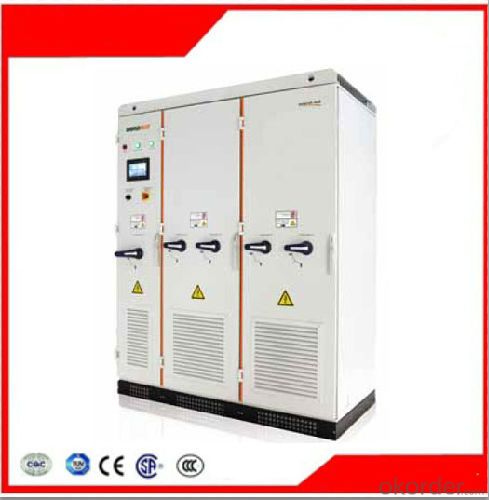
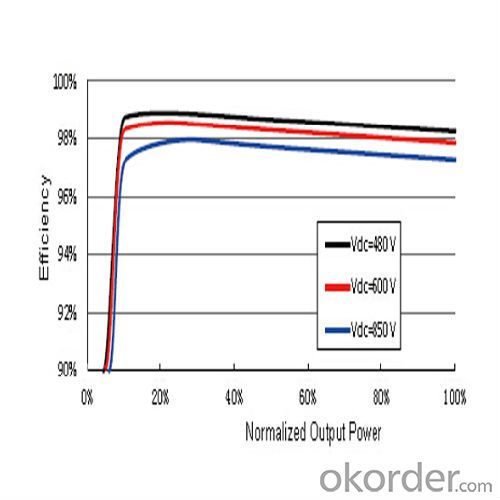
4. Photovoltaic Grid-Connected Inverter SG500MX-M Specification
Input Side Data |
|
Max. PV input power | 560kW |
Max. PV input voltage | 1000V |
Start voltage | 520V |
Min. operation voltage | 480V |
Max. PV input current | 1064A |
MPP voltage range | 480~850V |
No. of MPPTs | 1, 2, 3, 4 |
No. of DC inputs | 2 x 4 |
Output Side Data |
|
Nominal AC output power | 500kW |
Max. AC output apparent power | 550kVA |
Max. AC output current | 1018A |
THD | <3%(Nominal power) |
Nominal AC voltage | 315V |
AC voltage range | 252~362V |
Nominal grid frequency | 50/60Hz |
Grid frequency range | 47~52 / 57~62Hz |
Power factor | >0.99@default value at nominal power, adj. 0.9 overexcited~0.9 underexcited |
Isolated transformer | No |
DC current injection | <0.5 % In |
Efficiency |
|
Max. efficiency | 98.80% |
European efficiency | 98.60% |
Protection |
|
Input side disconnection device | DC load switch |
Output side disconnection device | AC load switch |
DC overvoltage protection | Yes |
AC overvoltage protection | Yes |
Grid monitoring | Yes |
Ground fault monitoring | Yes |
Overheat protection | Yes |
Insulation monitoring | Yes |
General Data |
|
Dimensions(W×H×D) | 1606×2034×860mm |
Weight | 1400kg |
Operating ambient temperature range | -30~+55℃ |
Night power consumption | <100W |
External auxiliary supply voltage | 220V, 8A |
Cooling method | Temperature controlled aircooling |
Ingress protection rating | IP21 |
Allowable relative humidity range | 0~95% no condensing |
Max. operating altitude | 6000m(>3000m derating) |
Fresh air consumption | 5575 m³/h |
Display | Touch screen LCD |
Communication | RS485/Modbus, Ethernet |
5. FAQ of Photovoltaic Grid-Connected Inverter SG500MX-M
Q1. What is the difference between inverter and solar inverter?
A1. Inverter only has AC inpput, but solar inverter both connect to AC input and solar panel, it saves more power.
Q2. What is the difference between MPPT&PWM?
A2. MPPT has higher efficiency, it can track the max power point and won't waste energy.
- Q:How does a solar inverter handle voltage dips or surges in the grid?
- A solar inverter handles voltage dips or surges in the grid by incorporating various protective mechanisms. During a voltage dip, the inverter's control system detects the change and adjusts its power output accordingly to maintain a stable voltage and frequency. It may also utilize energy storage systems to compensate for the temporary drop in grid voltage. In the case of voltage surges, the inverter employs surge protection devices to prevent damage to the system. Additionally, advanced inverters may have built-in voltage regulation capabilities to stabilize the output voltage even during significant fluctuations in the grid.
- Q:Can a solar inverter be used in systems with different module strings?
- Yes, a solar inverter can be used in systems with different module strings. Solar inverters are designed to be compatible with a wide range of module string configurations, allowing for flexibility in system design and installation. The inverter's maximum input voltage and power ratings should be considered to ensure compatibility with the different module strings, but as long as these specifications are within the inverter's limits, it can effectively convert the DC power generated by the module strings into AC power for use in the system.
- Q:What are the key safety features to look for in a solar inverter?
- The key safety features to look for in a solar inverter include overvoltage protection, ground fault protection, arc fault protection, and rapid shutdown capability. These features help ensure the safe and efficient operation of the solar system, protecting against electrical hazards and reducing the risk of fire or injury.
- Q:Can a solar inverter be used in extreme weather conditions?
- Yes, solar inverters are designed to withstand a wide range of weather conditions, including extreme heat, cold, humidity, and even harsh environmental factors. They are built to be durable and reliable, ensuring their functionality and performance in various climates and weather conditions.
- Q:Can a solar inverter be used with different solar panel types?
- Solar inverters are capable of being utilized with various types of solar panels. Their purpose is to convert the direct current generated by solar panels into alternating current, which is suitable for powering household appliances and injecting into the electrical grid. So long as the solar panels produce compatible levels of DC voltage and current, they can be connected to the solar inverter. Various solar panel types, such as monocrystalline, polycrystalline, and thin-film, may possess different electrical characteristics. However, modern solar inverters are typically equipped with advanced electronics that can adapt to these discrepancies. Nevertheless, it is crucial to ensure the solar inverter is appropriately matched with the solar panel specifications in order to achieve optimal performance and efficiency.
- Q:How does a solar inverter convert DC power to AC power?
- A solar inverter converts DC power to AC power by utilizing electronic components and a complex control system. The process involves several stages: first, the DC power generated by solar panels is converted into high-frequency AC power using a high-frequency transformer. This AC power is then rectified and filtered to create a stable DC voltage. The DC voltage is further processed by an inverter circuit, which rapidly switches the DC voltage on and off to create an AC waveform. Finally, the AC waveform is filtered and conditioned to match the desired output requirements, allowing the solar inverter to efficiently convert DC power from the solar panels into usable AC power for electrical devices.
- Q:Can a solar inverter be used with a smart home system?
- Yes, a solar inverter can be used with a smart home system. Smart home systems are designed to integrate with various devices and technologies, including solar inverters. By connecting a solar inverter to a smart home system, users can monitor and control their solar energy production, track energy consumption, and optimize energy usage based on real-time data. This integration allows for increased energy efficiency and convenience in managing solar power within a smart home environment.
- Q:How does a solar inverter affect the voltage stability of a solar system?
- A solar inverter plays a crucial role in maintaining voltage stability in a solar system. It converts the direct current (DC) generated by solar panels into alternating current (AC) suitable for use in homes and businesses. By monitoring and adjusting voltage levels, a solar inverter ensures that the power output remains consistent and within acceptable limits. This helps to prevent voltage fluctuations, voltage drops, and other electrical instabilities, ensuring a stable and reliable power supply from the solar system.
- Q:How do you calculate the payback period for a solar inverter?
- To calculate the payback period for a solar inverter, you need to determine the initial cost of the inverter and the annual savings or earnings it generates. Divide the initial cost by the annual savings or earnings to determine the number of years it will take to recoup the investment. This will give you the payback period for the solar inverter.
- Q:How does a solar inverter handle voltage sags or swells in the grid?
- A solar inverter handles voltage sags or swells in the grid by continuously monitoring the voltage levels. When it detects a sag or swell, it adjusts its internal circuitry to regulate the output voltage accordingly. This ensures that the connected solar panels continue to operate within their optimal voltage range, minimizing any negative impact on the overall power generation system.
1. Manufacturer Overview |
|
|---|---|
| Location | |
| Year Established | |
| Annual Output Value | |
| Main Markets | |
| Company Certifications | |
2. Manufacturer Certificates |
|
|---|---|
| a) Certification Name | |
| Range | |
| Reference | |
| Validity Period | |
3. Manufacturer Capability |
|
|---|---|
| a)Trade Capacity | |
| Nearest Port | |
| Export Percentage | |
| No.of Employees in Trade Department | |
| Language Spoken: | |
| b)Factory Information | |
| Factory Size: | |
| No. of Production Lines | |
| Contract Manufacturing | |
| Product Price Range | |
Send your message to us
Photovoltaic Grid-Connected Inverter SG500MX-M
- Loading Port:
- China Main Port
- Payment Terms:
- TT or LC
- Min Order Qty:
- 50 unit
- Supply Capability:
- 1000 unit/month
OKorder Service Pledge
OKorder Financial Service
Similar products
New products
Hot products
Hot Searches
Related keywords
